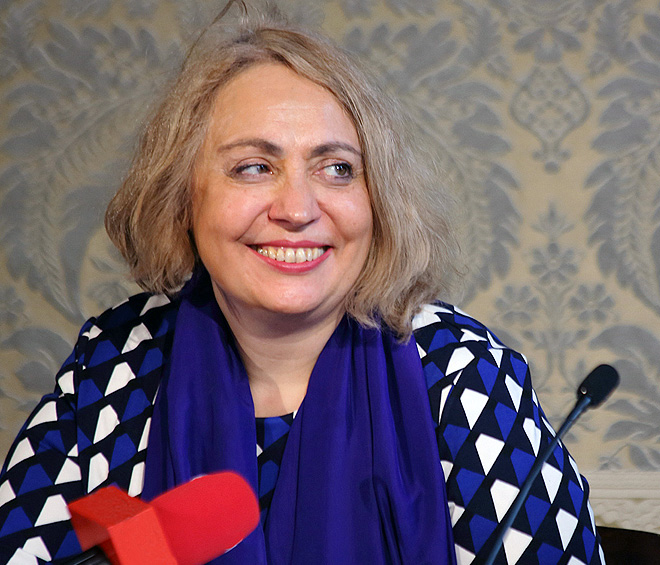
Ekaterina Degot. Photo: JJ Kucek.
by IZABELLA SCOTT
Styria is a hedonistic Austrian province, known for castles, spas, golden wine and Steirischer Herbst, an annual art festival founded in 1968 to champion radical art in the region. Steirischer Herbst (which means “Styrian autumn”) takes place in Graz, Austria’s second largest city, where the Nazi theory of “degenerate art” once held sway. In 2018, Russian curator Ekaterina Degot (b1958) took on the running of the festival for a five-year period.
Degot’s first iteration, titled Volksfronten, addressed the rise of populism across Europe and the question of whether contemporary art can engage in mass politics, or be used to fight fascism. I visited Graz in the autumn of 2018 for a two-day symposium titled Our Little Fascisms, part of the festival’s opening weeks. Polish feminist Ewa Majewska and political historian Ishay Landa, among others, asked some necessarily difficult questions about art, populism and politics. The wider festival programme of exhibitions, installations and performances, also looked at protest, Nazi legacies, popular art genres and the increasingly strained relationship between (elite) liberalism and (mass) democracy.
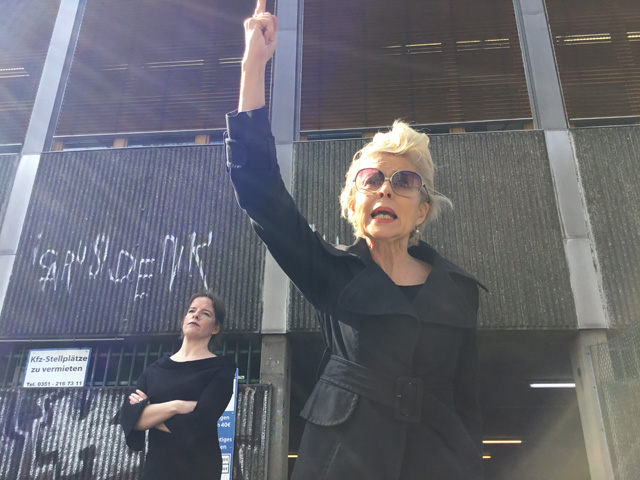
Anna Clementi and Angela Wingerath rehearsing for Zorka Wollny’s performance for Steirischer Herbst ’19, Berlin, 2019. Photo: Zorka Wollny.
This year, Degot’s theme is Austrian hedonism, and the festival examines Graz, in particular, and Europe more widely as a pleasure zone on the edge of a void. The festival’s title, Grand Hotel Abyss, comes from the writings of the Marxist philosopher Georg Lukács, who, in the 1930s, described blind hedonism before the apocalypse of mass nationalism, nazism and war. I caught up with Degot in advance of Grand Hotel Abyss (which opens on 19 September 2019) to discuss Graz’s particular strain of hedonism, furniture that can brainwash you, and the value of destruction.
Izabella Scott: Volksfronten, the title of last year’s festival, is a loaded word with multiple meanings across German and English. It contains both fascist and democratic overtones, and points to a number of political movements. Can you talk me through what the word means to you, and more widely?
Ekaterina Degot: That edition of Steirischer Herbst worked as a kind of prologue edition, which means the word will probably stay with the festival during the five-year period in which I curate it. Volksfronten is, indeed, a strong word, one that we deliberately kept in German. It translates as “popular front”, and refers first and foremost to a political coalition in 1930s Europe. In this period, the left came together to form a popular front, aimed at uniting against fascism. They had some success, with electoral victories in France and Spain. I wanted to look back to this moment, from a time when the left in Europe is splintered and there is no clear popular front that can face the rise of fascism.
One of the interesting nuances about the word in German is that volk has very different connotations from its translation as “people”. The English word has roots in Ancient Greece, the “agora” of popular public space; whereas “folk” connects very specifically to 19th-century German nationalism, and from there into nazism. Even today, German-speaking intellectuals tend to avoid the word volk. I’m interested in the uncertainty of this word, the way it’s imbued with fascist-romantic overtones and yet still retains a democratic sentiment: the people. The festival, under that title, asked questions such as: can the word “volk” be reclaimed by the left? Can we conceive of a 1930s-esque Volksfronten to unite against modern fascism? And, perhaps the question at the very heart of it: can we reclaim the popular from the populist?
,-photo--Socrates-Mitsios-.jpg)
Cibelle Cavalli Bastos, poster from the series Sonja Khalecallonin Las Venus Resort Palace Hotel, 2010. Photo: Socrates Mitsios.
IS: These are – perhaps counterintuitively – difficult questions for the intelligentsia. Liberalism has always been suspicious of the masses and, intentionally or not, intellectuals tend to work at a distance from the popular. Did you think about how to engage the wider population of Graz with this festival, which historically has been avant garde, conceptual, leftist, perhaps even elite?
ED: The very idea of presenting popular art in Steirischer Herbst is somewhat controversial because, since its inception in 1968, the festival has positioned itself as deeply avant garde, as you say. There is a particular context to this: at the time, it was a political move because Austria did not de-nazify in the same way as Germany following the end of the second world war, due to the “victim-narration”. This meant that, across the 50s and 60s, many former Nazis were teaching in universities and schools and occupying influential positions in the cultural sphere, and this conservative elite continued to propagate ideas around Entartete Kunst (degenerate art), a Nazi term that really meant modern art. In reaction to this stood the postwar Austrian avant garde, which included abstract art as well as artists and theorists who believed that modernist aesthetics could be used as a weapon against nazism. This was really the genesis of Steirischer Herbst. In this climate, introducing popular art to the programme felt like a statement. For example, the Bread and Puppet Theatre, a group founded in New York in the 1960s, makes works that really think about the popular: how to make politically engaged, popular theatre. For Steirischer Herbst, the group organised a political parade in Graz that was very inclusive, working with local participants, finding out what topics animated people. I was so glad to see the whole town reacting.
,-film-still,-courtesy-the-artist.jpg)
Jeremy Deller, Putin’s Happy, 2019. Film still, courtesy the artist.
IS: You said that Austrian nazism was not addressed in the postwar years, as it had been in Germany. Can you explain why?
ED: The story of Austria’s relationship to nazism has not always been clearly told. We know that Austria became part of Nazi Germany in 1938, as the result of the so-called Anschluss. At the time, the Anschluss was enthusiastically accepted in many regions of Austria, and specifically in Graz. This is because Graz was, even before the war, a very German-oriented city. Indeed, across the 1930s, there were long discussions about Austria joining Germany, and it was generally considered a mistake that, as a result of the first world war and the annexation of the Austro-Hungarian empire, Austria became its own nation. Of course, there were many voices in different political camps. But it’s safe to say that many were enthusiastic. However, this is not the narrative which prevailed. In 1943, the Moscow Declarations were in an alliance between the US, Soviet Union, China and the UK. These declarations positioned Austria as the first victim of Nazi Germany, and stated that the Anschluss was void. It was here that the story of Austria as a victim was born. In the postwar period, in this climate of victimhood, there was no conscious de-nazification movement, as took place in Germany. Many former Nazis lost their jobs right after the war, but, soon, they returned to their positions, especially in education and culture. There were cultural figures who would rarely be venerated in Germany, because of their relation to fascism, who remain celebrated in Austria, such as Friedrich Ludwig Jahn (1778–1852), a German nationalist who invented a system of gymnastics that became a tool of German patriotism. His statue stands in Graz Stadtpark. Today, there is still work to be done.
-Photo-Mathias-Volzke.jpg)
Yoshinori Niwa, Withdrawing Adolf Hitler from a Private Space, 2018. Photo: Mathias Völzke.
IS: This was demonstrated quite well by Yoshinori Niwa's project Withdrawing Adolf Hitler from a Private Space (2018) – one of the more inflammatory works of 2018’s festival – exhibited in a public square in Graz. Niwa invited local people to finally get rid of the Nazi memorabilia they had lingering in their attics, promising to shred and destroy all artefacts placed in a large recycling bin in the centre of town. There was a satirical tone to the work, but as I remember, the public response was fairly earnest.
ED: The people of Graz really did bring the memorabilia of their Nazi grandparents and put them in the bin, because these objects remain in people’s attics, gathering dust. People really don’t know what to do with them. Niwa’s work, despite its satirical tone, was a fairly realistic description of Graz today.
-Photo-Clara-Wildberger.jpg)
Yoshinori Niwa, Withdrawing Adolf Hitler from a Private Space, 2018. Photo: Clara Wildberger.
IS: Famously, one elderly woman carried a painting of Hitler into town by bus, and placed it in the bin.
ED: Yes, that was a great story. It was particularly memorable because she didn’t cover the painting up on her journey. There are postwar laws that make it illegal to show images of Hitler in a public space if that image is promoting or propagating Nazi ideology. It’s a grey zone, of course. What constitutes “promoting”? It’s legal to keep that object quietly, privately, or to bring it to a museum to be historicised. There are also shops that sell these objects, as historical artefacts; it’s not clear to whom they are selling, but usually it’s for secret admirers. Legally, it’s difficult to say if selling constitutes propaganda.
-Photo--Clara-Wildberger-2.jpg)
Yoshinori Niwa, Withdrawing Adolf Hitler from a Private Space, 2018. Photo: Clara Wildberger.
IS: I remember there was a vague myth going around that Niwa was not shredding the Nazi objects at all, but selling them for profit on the black market. What did you make of this paranoia?
ED: I was surprised that so much of the public discussion around this work was about the value of these objects. People would indeed ask: how can you throw it away, when it’s worth so much? Of course, they do have a cultural value of sorts. These objects could be historicised, and put in museums; many were before. But my answer was this: destruction also has value. And for me, that’s what the work was about: the political value, even the moral value, of destruction.
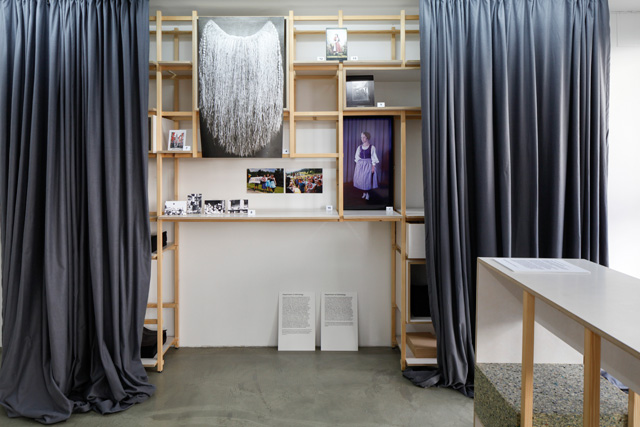
Department of Ultimology, What Where, 2018. Photo: Liz Eve.
IS: Some of these ideas were also contained in another work I saw at the festival, by the Department of Ultimology, a research group from Trinity College Dublin. Their project looked at traditional garments such as the Lederhosen, which have become symbolic of the fascist period. Of course, these garments had a life before the fascist period, too, and the department asked: can these traditions be rescued from their fascist overtones, or are they something that must be condemned and put on the historical trash pile?
ED: The Department of Ultimology looked into the traditional Austrian dress, the Tracht – Dirndls for women and Lederhosen for men – and made some interesting discoveries. This traditional dress is today considered a symbol of nationalism, and sometimes even a symbol of Austrian racism. However, this research showed that the Tracht was anything but traditional. Rather, it was deliberately promoted in the 1950s by urbanists. Strangely enough, it was the spiritual father of the Steirischer Herbst, Hanns Koren, a local folklorist and politician, who drove around villages in a small Volkswagen promoting this type of dress, at the very same time as he was promoting modernist art. In the villages themselves, there was no particular desire to wear these traditional garments. Rather, the desire came from the city, from a political will to make these village people more aesthetic, or represent something more nationalistic.
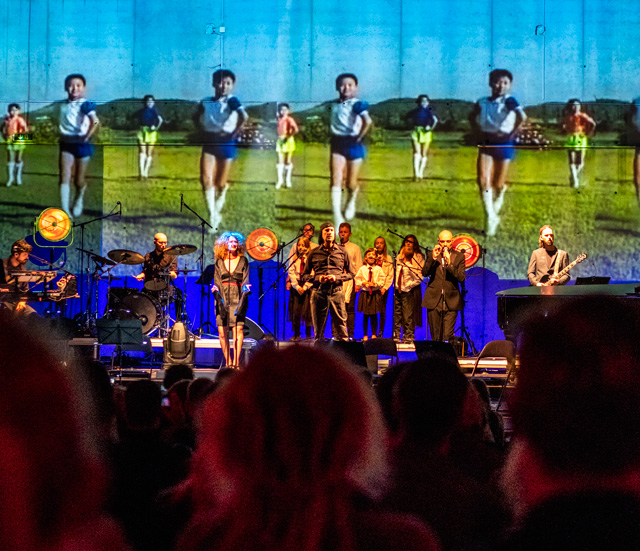
Laibach’s Sound of Music, 2018. Photo: Mathias Völzke.
I find it fascinating to consider the genesis of nationalism in postwar times, as opposed to romantic times – ie, nationalism that emerged not in the pan-Germanism of the 1920s and the lead up to nazism, but in the 1950s – at the time when Austria was occupied by British and American forces. In this period, it was believed that, in order to get rid of nazism, you simply had to support small Austrian nationalism. This is what the Slovenian avant garde music group Laibach addressed in their production of The Sound of Music (2018), which opened last year’s Steirischer Herbst.
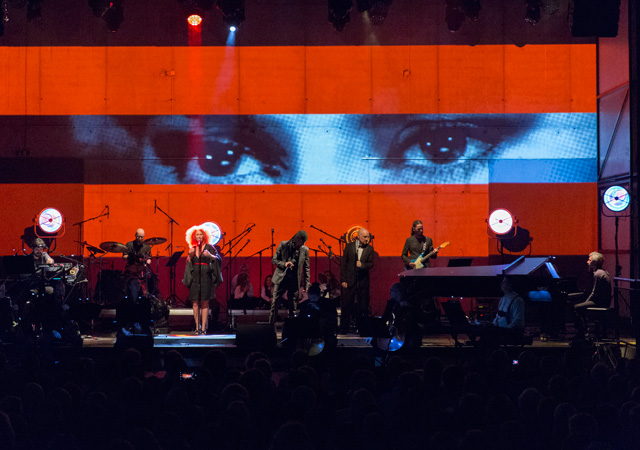
Laibach’s Sound of Music, 2018. Photo: Jasper Kettner.
IS: Laibach’s performance was a reminder that the original Sound of Music, made in the US in 1965, was a Hollywood fantasy. It positioned Austria as a total victim of the Anschluss, just as the Moscow Declarations proposed. Baron von Trapp, the film’s hero, opposes German nazism and the Anschluss and becomes a symbol of true Austria. But what is often overlooked is that von Trapp was also an Austrian nationalist. Is this what grew in the postwar period – an Austrian nationalism that was not anathema to nazism, but something close to it?
ED: Laibach’s performance identified this strain of postwar Austrian nationalism very well. Laibach have an interest in totalitarian regimes, and they provocatively made their own versions of the famous songs from The Sound of Music, illustrating how Hollywood sold a story of happy Austrian nationalism that was a quite out of kilter with the history of Austro-fascism, alive today. Some of their songs compared Austria to North Korea. Before the performance began, they made a very powerful statement. They stood and said: “Austria is a fascist state.” It was the very first statement of the festival, amplified for 1,000 people, a crowd that included high-ranking politicians. I found this to be a strong, critical statement, but in the end, it was rationalised as irony. Many people found a way to laugh.
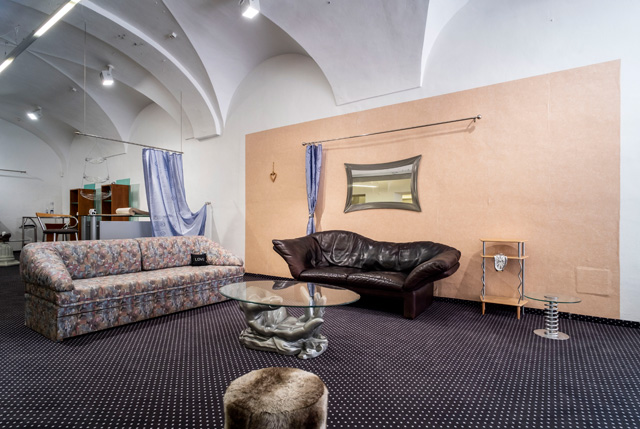
Henrike Naumann, Anschluss ‘90, 2018. Photo: Mathias Völzke.
IS: Another work that examined the Anschluss, but in a completely new way, was Henrike Naumann’s Anschluss ’90 (2018). This installation took over a furniture showroom, presenting a postmodern 1990s Anschluss, where Austria and Germany join. Is there any popular will for an Anschluss today?
ED: Naumann’s piece was very interesting because it made a comparison between the so-called reunification of Germany in 1990 and the Anschluss. In German, Anschluss means “joining”. Naumann grew up in the German Democratic Republic (GDR), so she experienced this 1990 joining first hand. She understands that German reunification was not a neutral unification. Rather, it was an ideological surrender, the taking over of communist GDR by capitalist Deutschland. So, Naumann looks back to this period, and examines it through the things people in the east were suddenly allowed to buy. The installation represents a typical apartment kitted out with 1990s mass-made furniture: bar stools, vases, cushions and kitchenware. She shows show these designs were intrinsically rightwing. It’s the first time I’ve seen a statement like this. Everybody over the age of 30 in Germany and Austria has lived with these objects at some point across the 80s and 90s. And Naumann shows how this furniture was secretly brainwashing us about capitalism and consumption being the only evolutionary possibility, the only way to achieve happiness.
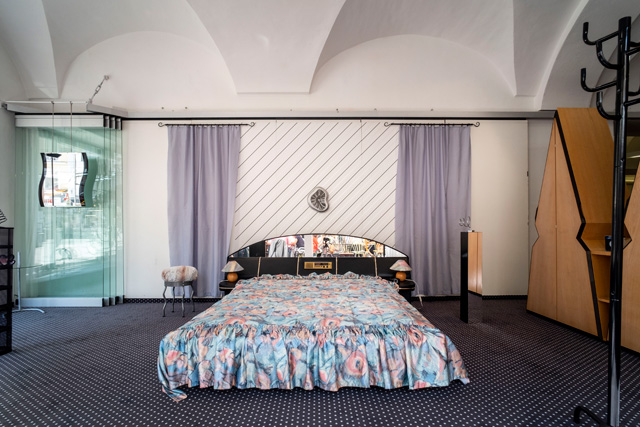
Henrike Naumann, Anschluss ‘90, 2018. Photo: Mathias Völzke.
IS: I would like to turn to a fictitious conversation, which acted as a kind of linchpin of the festival, between the philosopher Ernst Bloch and the composer Hanns Eisler. These two, writing in the 1930s, play an optimist and a sceptic as they discuss the relationship between contemporary art and populism. How did you come across this rather obscure dialogue, and how did it come to mean so much for Steirischer Herbst?
ED: I came across the text fairly late in my research. I find it to be very beautiful. It appears as a dialogue, as you say, which Bloch and Eisler wrote collaboratively. It’s an exchange which asks questions that we still do not have the answers to today, questions such as: can modern art help in the anti-fascist struggle, or is it too elitist, too un-understandable? Is art tragically cut from the people? It’s also lightly written, even funny. I really love this text, and that is why I performed it with our senior curator David Riff at the start of the symposium Our Little Fascisms.
IS: One of the speakers at that symposium was Tobias Ginsburg, an investigative journalist, who spoke about his months undercover in the German far right. He also spoke of Austria, Graz in particular, as a cradle of fascism. Is this something you have felt or witnessed during your time in Graz?
ED: What we can talk about in Austria very concretely is the Freedom Party (FPÖ), a rightwing populist party with roots in the Nazi period. The party’s politics are explicitly racist and anti-immigrant and culturally reactionary. This is a species of politics that we are seeing all across Europe, which I would call nationalist and ultra-right wing. The FPÖ was, until very recently, in coalition with the Austrian People’s Party (ÖVP), which is the conservative party, the party of decent people, people who are moderately progressive and ultimately conservative – but not fascist. And these people found themselves in bed with the FPÖ. The coalition has made every intellectual and progressive person in Austria very unhappy since the elections of 2017. But the rise of the FPÖ actually reaches much further back. In the 1999 parliamentary elections, with Jörg Haider leading the party, the FPÖ unexpectedly became the second largest party in Austria. In response, the magazine Camera Austria published an edition of black pages. Imagine, a thick, glossy art magazine with every page printed black. It was an expression of sadness and anger. That was 20 years ago. Since then, the FPÖ has risen to power. But, indeed, just a few weeks ago, on 17 May, came the “Ibiza scandal” – a video was leaked that implicates the current leader of the FPÖ, Heinz-Christian Strache, in corruption. The following day, Strache resigned. The landscape is changing very fast. A snap election has been called, which will be taking place, by chance, during Steirischer Herbst 2019.
IS: With the context of the FPÖ coalition, have you been afraid of censorship, that is to say, having the festival’s funding cut back?
ED: You are right to say that, in general, contemporary censorship functions through funding all over the world. Right now, our funding remains the same as it always was, due to a fixed five-year-contract that covers the complete period of my directorship. In the aftermath of our first edition, the FPÖ openly published 103 questions for the Steirischer Herbst festival that we had to answer publicly. Most of these questions were of a financial and managerial nature. There was not a single question in which the FPÖ directly questioned our politics – they would not be so explicit. Instead, they were trying to find problems in our financial and organisational workings. What I’ve found very interesting is that our upcoming festival in September 2019 has a topic that relates to the question of pleasure, food and tourism in Graz. In some ways, it appears far less political than our previous edition, Volksfronten. But I have already encountered much more anxiety and concern from some local officials. And also from the regional FPÖ, which sent a protest letter, a public outcry to the press, after we released the concept in the spring. It seems that these are the questions they want to avoid.
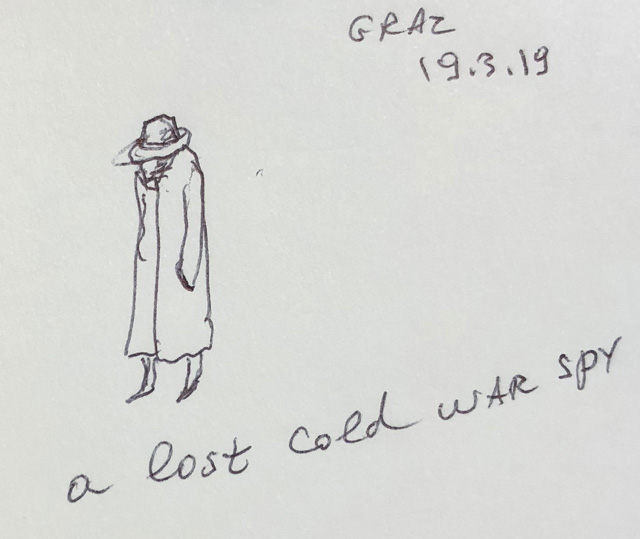
Nedko Solakov, “a lost cold war spy”, sketch, 2019. Courtesy the artist.
IS: Let’s talk about Steirischer Herbst 2019. You have titled it “Grand Hotel Abyss”, which comes from an essay by Georg Lukács, in which he described Europe as The Grand Hotel Abyss: “a beautiful hotel, equipped with every comfort, on the edge of an abyss”. It this a description of hedonism before the apocalypse?
ED: There are many layers to it. First and foremost, we were working out of Graz, which is a very beautiful town, but not in a modern sense. There are lots of architectural styles – renaissance, fake renaissance and baroque. It’s also a place where the counter-reformation was very strong, so the Protestants were killed and chased away. Art was understood to be a very good propaganda tool, and those people realised that propaganda worked through seduction: seductive images, seductive forms. This whole seductive attitude to culture might be described as pleasure, or hedonism. And you can feel this in Graz very strongly, that this historical attitude to pleasure has never abated. This counter-reformation continues now.
IS: If Europe, Graz especially, is a grand hotel, or a kind of pleasure zone, what is the abyss? When you talk of pleasure as essentially counter-reformation, it makes me think of climate change, or an unwillingness to adapt to the changes in lifestyle that climate change demands. While Austria, or Europe, is a pleasure zone, in turn there are sacrifice zones: sinking cities, toxic rivers, industrial dead zones.
ED: Climate change is definitely part of the abyss, but we now have an abyss on all fronts – ecologically, but also politically: the fascism, the ultra-right nationalism, the racism that is awaiting us. Of course, the ecological metaphor is there, too. The Grand Hotel is a metaphor about lifestyle. Lukács used it to describe Schopenhauer, Adorno and Benjamin as philosophers sitting in a grand hotel. He could have used the image of the Titanic, with its ballroom where the orchestra still plays as the ship sinks. We are using it as a metaphor for the lifestyle, so present in Graz, for a lifestyle where baroque art and the wellness of industry and happiness are booming, while catastrophe is waiting just around the corner.
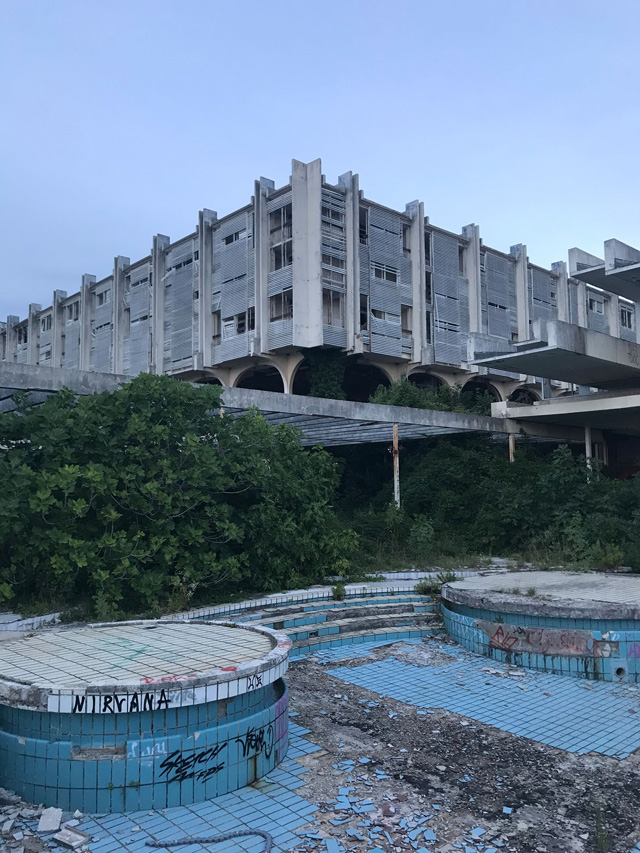
Haludovo Palace Hotel, Krk Island, Croatia, 2019. Photo: Bojan Djordjev.
IS: Many of the artworks you are including in this edition look at the history of wellness hotels in Austria, where bourgeois men and women would come to take the air in Alpine resorts. Perhaps in the future, clean air will be the greatest commodity of all.
ED: There are indeed a number of works that relate to the historical roots of wellness hotels in the region. One of these, in Bad Gastein – a spa town in an Alpine valley in the centre of Austria, full of belle époque hotels – was very popular among Nazi officers before the war. Strangely, it was not just the air, but also gas that was used therapeutically. They discovered a strange gas in the air of a tunnel inside the mountain of Bad Gastein, which they thought to be very healthy. But they were hugely mistaken. The gas, it was later understood, was radioactive.
• Steirischer Herbst 2019: Grand Hotel Abyss takes place in Graz, Austria, from 9 September to 13 October 2019.